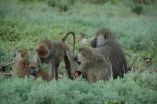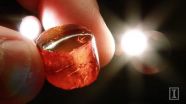(Press-News.org) DURHAM, N.C. -- A study of dominance in female baboons suggests that the route to a higher rank is to maintain close ties with mom, and to have lots of supportive sisters.
A female baboon's social status is dictated not by size or strength, but by the rank of her mother -– the higher the mother is ranked, the higher-ranked her daughter will be. For this reason, dominance rank in female baboons is thought to be determined at birth. Females born to high-ranking mothers are guaranteed a good spot in the pecking order, whereas females born to low-ranking mothers are usually stuck with their lot.
"Daughters of high-ranking females generally mature more quickly, produce more offspring, and have better access to food and mates. It's like being born with a silver spoon in your mouth," said Duke University biology professor Susan Alberts.
But her group's study in the August 2014 issue of Animal Behaviour suggests there may be more social mobility in baboon society than previously thought.
Alberts and graduate student Amanda Lea of Duke and colleagues studied data from a population of wild yellow baboons that has been under close observation since 1971 near Mount Kilimanjaro in Kenya.
The researchers determined dominance rank for the animals by analyzing pairwise interaction data collected for nine social groups over 33 years (from 1977 to 2010), and noting how the animals behaved. Females who are higher on the social ladder harass those lower in the ranks as a reminder of their right to first dibs on food or favored resting spots. A high-ranking female may assert her dominance by baring her teeth, lunging or slapping the ground, while a subordinate cowers, grimaces in fear, averts her gaze or slinks away.
By comparing each female's rank at sexual maturity -- measured as the age at her first period -- with her position when she first became a mother, the researchers were able to track social mobility across early adulthood.
Nearly 25 percent of females either climbed up or slipped down the baboon social ladder, rising higher or lower than expected by the time they became mothers.
Downwardly mobile females had mothers who spent less time with them while they were growing up -- either because mothers and daughters were separated during a splitting of the group or because the mothers died before their daughters reached adulthood. Such was the case with a young female named Abby, whose mother died when she was two and who never managed to achieve her expected rank.
It's no surprise that having mom around is a good thing. Mothers intervene on behalf of their daughters in 'playground spats' over food or mates, and thus help ensure their daughters' place in the pecking order, Alberts said.
But having the support of sisters proved to be a big help, too. The researchers found that females with more sisters were more likely to reach the rank transmitted from their mother.
Sisters give each other a boost by ganging up on unrelated rivals. But sisterly love has its limits: Older sisters help their younger sisters out when it comes to rising above females from other families, but when it comes to rising in rank within the family, older sisters aren't much help. The researchers found that the more sisters a young female had, the less likely those sisters were to cede their own position to the younger sister.
Fathers and brothers had surprisingly little influence on the social status of their female kin, possibly because they tend to mate with multiple female partners, making their allegiances murkier than they are for females.
"One of his daughters may be fighting with another daughter from another mom, for example, or with another female that he wants to mate with," Alberts explained, so he can't or won't intercede.
The study is part of a larger field of research on the benefits for our animal cousins of maintaining strong social ties with relatives.
INFORMATION:
Niki Learn, Marcus Theus and Jeanne Altmann of Princeton University were also authors on this study. Funding for the study was provided by the National Science Foundation (most recently under IOS 0919200 and DEB 0846286). Additional support was provided by the National Institute on Aging (R01AG034513 and P01AG031719) and the Chicago Zoological Society.
CITATION: "Complex sources of variance in female dominance rank in a nepotistic society," Lea, A., et al. Animal Behaviour, August 2014.
DOI: http://dx.doi.org/10.1016/j.anbehav.2014.05.019
Supportive moms and sisters boost female baboon's rank
2014-07-30
ELSE PRESS RELEASES FROM THIS DATE:
Scientists pinpoint bladder cancer patients who could benefit from 'tumor-softening' treatment
2014-07-30
Scientists in Manchester have identified a protein that could help doctors decide which bladder cancer patients would benefit from a treatment that makes radiotherapy more effective, according to a study* published in the British Journal of Cancer (BJC).
The team from The University of Manchester, funded by the Medical Research Council, found that patients whose bladder tumour had high levels of a protein, called 'HIF-1α', were more likely to benefit from having carbogen – oxygen mixed with carbon dioxide gas – and nicotinamide tablets at the same time as their radiotherapy. ...
The promise and profits driving our pill-popping culture
2014-07-30
New Rochelle, NY, July 30, 2014—We have pills to ease pain, to cure infection, to help us lose weight, to treat chronic conditions, and to enhance our sexual and athletic prowess. Why do pills play such a central role in today's society and could we benefit from taking fewer pills? This provocative topic is explored in the article "'Take Your Pill': The Role and Fantasy of Pills in Modern Medicine," published in The Journal of Alternative and Complementary Medicine, a peer-reviewed publication from Mary Ann Liebert, Inc., publishers. The article is available free on The ...
Decades-old amber collection offers new views of a lost world
2014-07-30
CHAMPAIGN, Ill. — Scientists are searching through a massive collection of 20-million-year-old amber found in the Dominican Republic more than 50 years ago, and the effort is yielding fresh insights into ancient tropical insects and the world they inhabited.
When the collection is fully curated, a task that will take many years, it will be the largest unbiased Dominican amber collection in the world, the researchers report.
Perhaps the most striking discovery thus far is that of a pygmy locust, a tiny grasshopper the size of a rose thorn that lived 18- to 20-million ...
F1000Research brings static research figures to life
2014-07-30
F1000Research today published new research from Bjorn Brembs, professor of neurogenetics at the Institute of Zoology, Universitaet Regensburg, in Germany, with a proof-of-concept figure allowing readers and reviewers to run the underlying code within the online article. This represents an important leap forward for scientific publishing, by demonstrating a completely novel framework for assessing the quality of a scholarly output.
Figure 3 in fact doesn't really exist. The authors submitted their data and their code to F1000Research, and the figure is generated 'on the ...
Income is a major driver of avoidable hospitalizations across New Jersey
2014-07-30
NEW BRUNSWICK, N.J. – The household income of its residents is the most important factor in whether a community has high or low rates of avoidable hospital visits – conditions that could be better managed in a doctor's office or other health care settings if treated at an early stage, according to a report released today by the Rutgers Center for State Health Policy (CSHP).
An analysis of hospital billing records and demographic data by Rutgers researchers across 13 low-income communities in New Jersey found that as an area's per capita income rises, the number of patients ...
Dimly lit working environments: Correcting your body clock is possible!
2014-07-30
This news release is available in French.
Researchers at Inserm, led by Claude Gronfier (Inserm Unit 846: Stem Cell and Brain Institute), have, for the first time, conducted a study under real conditions on the body clocks of members of the international polar research station Concordia. The researchers have shown that a particular kind of artificial light is capable of ensuring that their biological rhythms are correctly synchronised despite the absence of sunlight. The full significance of this result can be appreciated with the knowledge that disturbance to this ...
Saving seeds the right way can save the world's plants
2014-07-30
KNOXVILLE—Exotic pests, shrinking ranges and a changing climate threaten some of the world's most rare and ecologically important plants, and so conservationists establish seed collections to save the seeds in banks or botanical gardens in hopes of preserving some genetic diversity.
For decades, these seed collections have been guided by simple models that offer a one-size-fits-all approach for how many seeds to gather, such as recommending saving 50 seed samples regardless of species' pollination mode, growth habitat and population size.
A new study, however, has found ...
Neuro researchers advocate for a shift in thinking for stroke rehabilitation
2014-07-30
Los Angeles, CA (July 30, 2014) With the advent of non-surgical modalities, stimulation of the brain has become a popular science and researchers must work to ensure systematic methods for consistent results in the study of stroke rehabilitation. A new study out today in The Neuroscientist discusses a systematic shift in perspective and suggests that chronically stimulating premotor areas (PMAs) of the brain would strongly promote stroke motor recovery, for example by restoring balance between the stroke and the intact hemispheres while establishing greater widespread connectivity. ...
Money talks when it comes to acceptability of 'sin' companies, study reveals
2014-07-30
Toronto – Companies who make their money in the "sin" industries such as the tobacco, alcohol and gaming industries typically receive less attention from institutional investors and financial analysts.
But new research shows social norms and attitudes towards these types of businesses are subject to compromise when their share price looks to be on the rise. A paper from the University of Toronto's Rotman School of Management found that institutional shareholdings and analysts' coverage of sin firms were low when firm performance was low but went up with rising performance ...
Brain response to appetizing food cues varies among obese people
2014-07-30
Washington, DC—People who have the most common genetic mutation linked to obesity respond differently to pictures of appetizing foods than overweight or obese people who do not have the genetic mutation, according to a new study published in the Endocrine Society's Journal of Clinical Endocrinology & Metabolism (JCEM).
More than one-third of adults are obese. Obesity typically results from a combination of eating too much, getting too little physical activity and genetics. In particular, consumption of appetizing foods that are high in calories can lead to weight gain. ...




